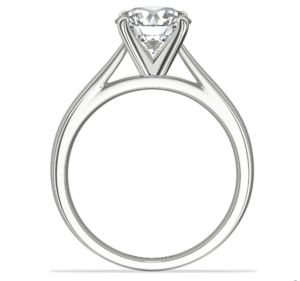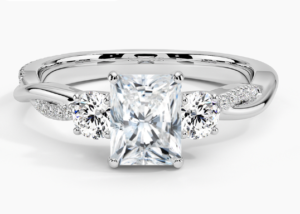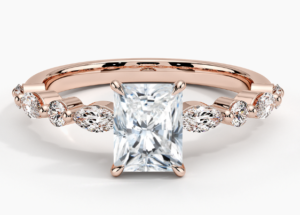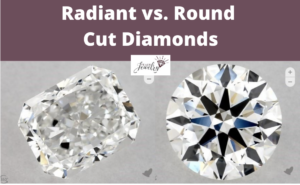
The cut of a diamond determines everything from its visible appearance and light performance to the apparent size and way it fits in a setting.
Two cuts you might explore are radiant and round diamonds.
The main difference between radiant and round cut diamonds is radiant cuts have a squarish or rectangular shape with beveled corners, while round cuts are circular all the way around. They both demonstrate exceptional fire and brilliance as the center diamond in an engagement ring.
Let’s compare radiant versus round cuts across their most important qualities, including an overview of each, their costs, clarity, color, popularity, and more.
What are Radiant Cut Diamonds?
A radiant cut features 70 brilliant-cut facets across the table and pavilion.
With their triangular and kite shapes, they effectively collect light, bounce it around, and reflect it back to the viewer in a way that minimizes leakage.
Most radiant cuts are rectangles, with a length to width ratio between 1.20 and 1.30. When they’re within this range, there’s no mistaking it as a square.
On the other hand, some have ratios between 1.0 and 1.05. To the naked eye, these diamonds will appear as a square.
For example, here’s a comparison of two radiant cuts with distinct ratios.
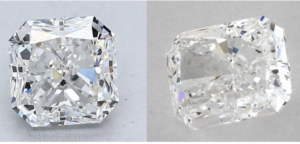
There isn’t a right or wrong here — it’s just a matter of preference.
The cut was designed in 1977 by Henry Grossbard, who sought to combine the best features in emerald and round cuts.
What are Round Cut Diamonds?
Round cuts are the classic style for an engagement ring diamond.
Its edges are all rounded, and they often feature 58 brilliant-cut facets that maximize light return.
As an example, here’s a round-cut diamond in high-resolution.
Notice the shape of its facets, and how they’re similar to the radiant cut.
On the vendor’s website, you can rotate the image 360 degrees to view how it appears at each angle.
The optimal length to width ratio is 1.0, but you may find ones that extend beyond that in a way that lowers its cut grade.
The cut really exploded in popularity in the late 1910s, when evidence mounted that it offered truly superior light performance compared to all other cuts.
How are Radiant and Round Cuts Different?
1. Cost
If you’re comparing radiant versus round cuts, one of the most important factors you’re likely considering is cost.
That’s because there’s often a meaningful difference in price between diamond cuts.
To provide real examples, I compiled prices for 241 radiant and round cuts from James Allen, the online vendor where I bought my wife’s engagement ring.
They had the following grades:
- Carat: 1.00
- Cut: Excellent
- Color: G
- Clarity: VS1
For the radiant cuts in my sample, the average cost was $4,148, with a range of $3,170 to $5,500.
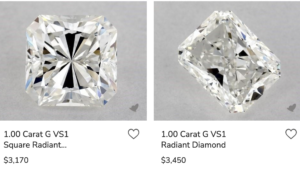
The round cuts averaged $6,824. The range was $4,790 to $9,240.
That puts round cuts at 65% more expensive than radiant cuts. The exact difference depends on specific qualities like the types of inclusions and aspects of its cut grade.
But in general, you’ll experience savings by choosing radiant over round, and you can put it toward a higher carat weight or an improved setting.
2. Settings
Don’t neglect the importance of a high quality setting for your engagement ring.
While radiant and round cuts fit a variety of settings, there are a few considerations.
The first is that round cuts often stand alone in a solitaire setting because they exhibit the most brilliance. The center diamond is the most expensive part of a ring, so many buyers don’t want to distract from it with accents.
To illustrate, here’s a round-cut diamond in a cathedral setting.
The two arches extend high above the band to display it prominently.
In this case, it’s not necessary to include additional diamonds for added sparkle.
But I’ll provide a contrast as well.
Let’s say you prefer a one-carat round cut, but your budget restricts you to one that’s around 0.80 carats.
One solution is to choose a halo setting, which circles the main diamond with small gems.
Check out this one.
It can create the illusion of a larger single diamond because from a distance, they blend together.
Adding a halo is far less expensive than adding the equivalent carat weight to your center diamond.
If you’re exploring a setting for your radiant cut, there are lots of options such as:
- Pave
- Three-stone
- Channel
- Solitaire
- Antique
I’ll provide a few real examples.
Here’s a three-stone setting with a radiant cut at its center surrounded by two round-cuts and pave.
The radiant cut is still the most prominent aspect of the piece, but it’s complemented by accents that add glimmer when it’s twirled.
This one includes alternating round and marquise cuts along the band, all surrounding a radiant cut in the middle.
These illustrate that both round and radiant cuts fit many types of settings. It’s worth pairing them with various styles to learn which one is best for you.
3. Popularity
Round cuts are by far the most popular shape for engagement rings. Many estimates put them at close to 70 percent of the market.
There’s a few reasons for this.
The first is that it’s still viewed as the traditional style. When you picture an engagement ring, you probably think of a round-cut diamond in a solitaire setting.
The second is it displays the most brilliance. Light performance is one of the most coveted traits in jewelry, and no cut has managed to exceed round in this area.
As another example of their popularity, I compiled research on 250 celebrity engagement rings dating back to 1936.
Even though celebrities only chose round cuts 30 percent of the time, that was still the most popular cut.
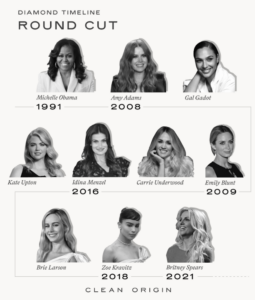
Radiant cuts generally make up about three percent of engagement ring sales. The advantage of this style is it offers strong light performance without the price premium of a round cut.
In my research on celebrity engagement rings, it matched the general public at 2.4%.
So if you’re looking for an alternative to the classic round cut, radiant cuts fit the bill.
4. Clarity and Color
During your time shopping for a diamond, you’ve likely come across the Gemological Institute of America’s clarity and color grades.
We’ll start with clarity grades for radiant and round cuts.
The scale starts at flawless — which means no inclusions are visible at 10x magnification — and moves down to I3, where the diamond has heavy imperfections.
In between, there’s:
- Internally flawless
- VVS1 and VVS2
- VS1 and VS2
- SI1 and SI2
- I1 and I2

Round cuts hide the visible appearance of inclusions more than any other cut because of their brilliant-cut facets.
So you’re more likely to find a round-cut with an SI1 clarity grade that’s flawless to the naked eye than you are to find the same with a step-cut diamond like emerald or Asscher.
For example, here’s a side-by-side comparison of two SI1 diamonds.
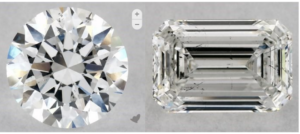
The round-cut looks far cleaner, even in high-resolution.
For radiant cuts around one carat, you can also start your search at SI1. But you’ll likely have to move up the scale to VS2 or VS1 to find one that’s eye-clean.
The same idea is true for color. Round cuts are more effective at hiding yellow tints than radiant cuts, though both do so better than step-cut diamonds.
In both cases, start your search at I color grades, but you may have to move up to H or G to find one that appears colorless to the naked eye.
Are There any Similarities Between Round and Radiant Cuts?
The primary similarity between round and radiant cuts is brilliant cut facets designed to maximize brilliance and fire.
You’ll often hear round diamonds referred to as “round brilliants” and radiants as “square modified brilliant.”
This is in contrast to step-cut diamonds, with long facets that stretch parallel across the gem.
The other similarity relates to cut. Although there might be instances where you choose a slightly higher color or clarity grade for a radiant cut, I always recommend excellent cut grades.
Cut is the quality most impactful on brilliance, and it’s worth the premium compared to a very good grade.
But if you view the GIA report for a radiant and round cut, you’ll notice at least one difference.
On the left is the “Grading Results” section on the report for a radiant cut, and on the right is one for a round cut.
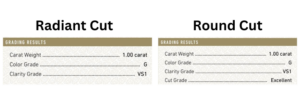
As you see, there’s no cut grade for the radiant cut. This is because the GIA doesn’t provide a cut grade for fancy shapes. There are too many variations for each shape to provide a consistent standard.
Instead, rely on other measurements like:
- Proportions
- Dimensions
- Symmetry
- Polish
- Girdle thickness
Each plays a role in the quality of its cut and light performance.
How to Decide
Although radiant and round cuts are fitting choices for your engagement ring, there are important differences to know as you explore which style is right for you.
Here are some guidelines you should use.
Consider a radiant cut if:
- You’re interested in an alternative to the popular round cut
- You want to pay less per carat and put the savings toward higher cut, clarity, or color grades
- The squarish and rectangular shape is appealing to you
Opt for a round cut if:
- You want a diamond that often has the light performance to stand alone in a solitaire setting
- You’re willing to pay more per carat compared to fancy shapes
- The classic style for an engagement ring appeals to you
Pair radiant and round cuts with multiple types of settings, and you’ll discover the perfect combination for your ring.
When weighing between radiant and round cut diamonds for engagement rings, consider your budget and style preference. Radiant cuts offer a modern look and more carat for your buck, great for those who appreciate a unique shape and want to maximize size within a budget. Round cuts, while more traditional and sparkling, come at a higher price point. It's wise to view both cuts in different settings, and if possible, in person to get a feel of their appearance on the hand before making a decision.
Chuck Harris, Team Member at Teach Jewelry
Radiant vs. Round Cut Q&A
Q: How does the facet arrangement in radiant and round cut diamonds affect their fire and brilliance?
A: The radiant cut’s 70-facet arrangement enhances both the fire (color dispersion) and brilliance (white light reflection), making it a good choice for those who appreciate a colorful and bright diamond. On the other hand, the round cut’s 58-facet arrangement is optimized for brilliance, often making it appear brighter and more sparkling than a radiant cut.
Q: Are there particular color or clarity grades that complement radiant and round cut diamonds?
A: Radiant cuts, due to their facet pattern, can hide inclusions and color tints better than round cuts. Therefore, you might choose a lower color or clarity grade for a radiant cut without affecting its appearance significantly. Conversely, round cuts are more transparent, so higher color and clarity grades are often preferred to showcase their optimal light performance.
Q: How do the different corner and edge designs of radiant and round cut diamonds influence their durability and setting choices?
A: Radiant cut diamonds have trimmed corners which can be more durable and less prone to chipping compared to round cut diamonds. The trimmed corners of radiant cuts are also versatile for various settings, while the round cut’s smooth edges require precise setting designs to ensure the diamond is held securely.
Q: Is there a noticeable difference in the visual size between radiant and round cut diamonds of the same carat weight?
A: Due to their different shapes and facet arrangements, a radiant cut diamond may appear larger from the top view than a round cut diamond of the same carat weight. This is because the radiant cut’s elongated shape covers more surface area on the finger, while the round cut’s symmetrical design may appear more compact.

Jacob Clarke
Jacob Clarke is the founder of TeachJewelry.com.
He earned an Applied Jewelry Professional Diploma from the Gemological Institute of America (GIA) and now brings you essential information about diamonds, settings, and more.
Jacob has consulted with leading jewelry brands, and his work has been cited in Clean Origin, Diamond Nexus and industry publications.
He's also a member of the International Gem Society.
He enjoys discussing jewelry with readers, so contact him with any questions at jacob.clarke@teachjewelry.com.


